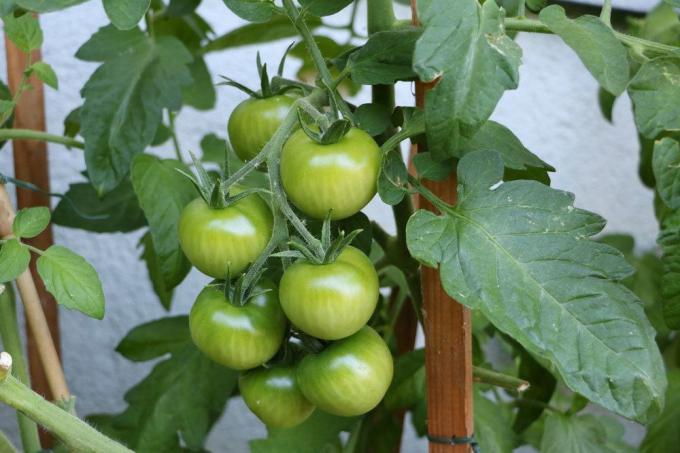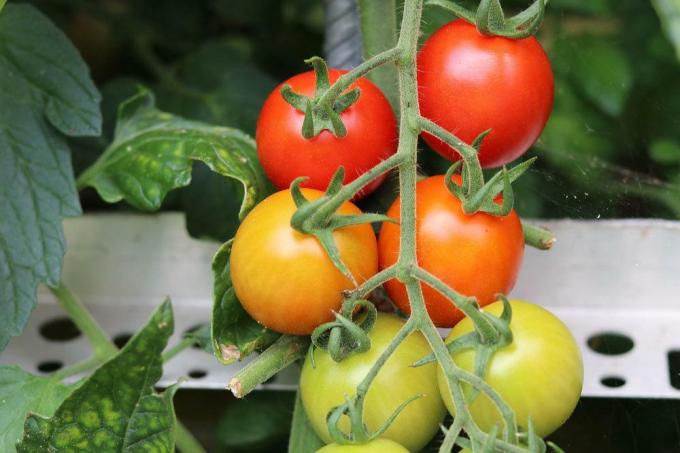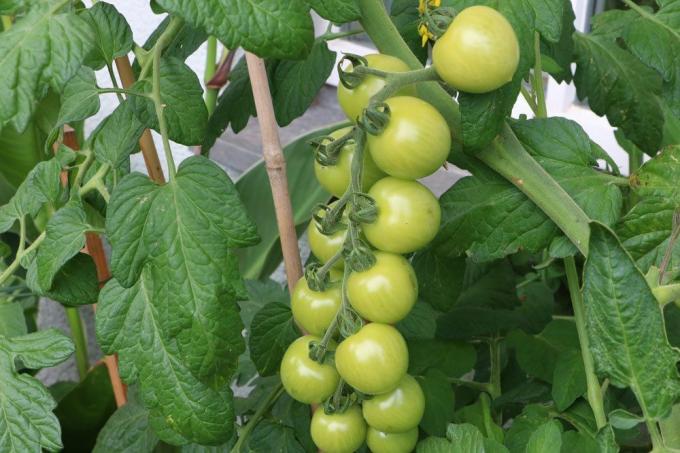
table of contents
- causes
- Temperatures too low
- Too much leaf mass
- Green collar disease
- Ripe tomatoes
- Reduce the watering amount
- Reduce light
- Pick green and let ripen in the house
Tomatoes, which by the way belong to the berries, taste best in summer. During the ripening process, the red varieties usually turn from an initial green to a juicy red. The red color is supposed to protect against extreme solar radiation, signal full maturity and at the same time attract animals. But sometimes the fruits just don't want to turn red. This can have different causes, but can usually be remedied with a few little tricks.
causes
It takes about eight to nine weeks from the planting of the seedling to the fully ripe fruit. The red color is the last development step of the tomato before harvest and usually only takes a few days. For various reasons, however, this last step can be delayed or even not taken at all.
Temperatures too low
- Tomato plants are very warm
- Make sure it is in a sunny location protected from rain
- Do not plant outdoors before the ice saints
- Frost is deadly for plants and fruits
- In greenhouse crops it can get very hot very quickly
- Adequate irrigation and ventilation are particularly important
- Temperatures that are too cold slow down the development of plants and fruits
- Despite fruit formation, the red color only occurs slowly or does not appear
- Fruits stay green and unripe
- Temperatures of at least 15 ° C required outdoors
- In the greenhouse, avoid temperatures of more than 30 ° C
Too much leaf mass
Another reason for a delay in ripening or not turning red in tomatoes can be too much leaf mass. Tomato plants are constantly forming new shoots and leaves. The more shoots and leaves they form, the less energy they have to develop and ripen fruits. One can remedy this by keeping the plants regularly maxed out, i.e. cutting out superfluous shoots. The clippings can then remain on the ground as mulch.
tip: The bottom leaves of tomato plants should generally be removed to counteract the dreaded late blight and brown rot.
Green collar disease
In the so-called green collar disease, the ripening process is disturbed, so that the fruits do not turn completely red. At the base of the stem there remains a circular, green stripe that is very hard, which also continues under the skin. The green is clearly distinguished from the red. The cause can be too much sunlight, temperatures above 30 ° C, too intensive watering as well as a lack of potassium or excess nitrogen.
This disease can be avoided by exposing the plants to strong sunlight and heat easily shaded, does not fertilize too much nitrogen and pay attention to a sufficient supply of potassium and magnesium. A soil analysis in advance can be useful.
tip: There are varieties that are particularly susceptible to this disease such as B. 'Harzfeuer', which should be taken into account when choosing a variety. Small-fruited cherry, panicle and bush tomato varieties are relatively rarely affected.
Ripe tomatoes
How the tomatoes turn red after all
To promote the ripening process in the greenhouse, you can hang bananas or apples next to the plants, for example. These fruits give that Maturation gasEthylene what can speed up the ripening process of the tomatoes. Tomato plants also produce this gas themselves, but they have to use a lot of energy for which they need a lot of heat and water. Another method is suitable for the greenhouse and for the bed.
- You need a base for this, for example a wooden board
- Place the board on the ground next to the plant in question
- This is to prevent the fruit from coming into contact with the ground
- Then bend the plant
- Tomatoes should be on the board
- Then put a mobile cold frame or cold box over the fruit
- Also cover the bed with opaque fleece
- Remove cover once a day to ventilate
- Depending on the weather, fruits ripen within one to three weeks

tip: Even if the appetite for ripe tomatoes is great in summer, one should never eat unripe, green tomatoes, because they are poisonous with the exception of special green varieties. The solanine content in unripe fruits is so high that it is harmful to health.
Reduce the watering amount
The deprivation of water can induce the plants to promote the ripening of the fruit. However, you shouldn't start doing this before autumn. As long as the plant is growing and producing fruits, it is dependent on a regular and abundant supply of water.
In autumn, when the fruits have reached their final size and are not really red want, you lengthen the intervals between the individual waterings and only pour about every three Days. The reduced water supply is intended to signal to the plant that its growth is complete. As a result, they put all their energy into the ripening process of the fruit.
Reduce light
The situation with the withdrawal of light is similar to that of dehydration. As long as the tomato plant is growing and producing fruits and seeds, it cannot do without sufficient light either. As soon as the fruits are fully grown, they get by with significantly less light, because the light intensity hardly plays a role in the red color of the fruits. They can turn red even in complete darkness. To speed things up, you can now put tomatoes in a pot or bucket in a shady place and cover the plants in the bed with a plant fleece.
Pick green and let ripen in the house
It often happens that the tomato season in the garden is actually over, but many fruits are still green. Before the frost kills them, they should be harvested and allowed to ripen indoors. It is best to harvest them as soon as temperatures drop permanently below 10 ° C.
- Always harvest unripe tomatoes with the stem
- Without a handle, cracks may develop at the base of the handle
- Cracks are entry points for germs
- Mold often forms on the cracks and the fruits spoil
- Green tomatoes for subsequent ripening should not have any damaged areas
- Check fruits for brown spots, risk of brown rot
- Tomatoes can also ripen on the plant
- To do this, cut off the entire plant
- Hang tomato plants upside down at a temperature of 18-20 ° C
- A room with high humidity, for example in a basement
- No light required for subsequent ripening
- Typical red color will show up within the next few weeks
Individual fruits can be placed in flat fruit boxes and stored in a suitable place. If possible, the tomatoes should not lie on top of each other and should be regularly checked for damage or rot and the corresponding fruits should be sorted out. If you want, you can put an apple in the box and use the ripening gas flowing out for the ripening process.

Alternatively, the green, unripe fruits can also be wrapped in newspaper, in a shoebox or simply put in a bowl, covered, and stored in a warm room until red are. Gradually the fruits turn red and can be eaten. As a rule, these measures do not reduce the taste or aroma of the ripe fruit.

